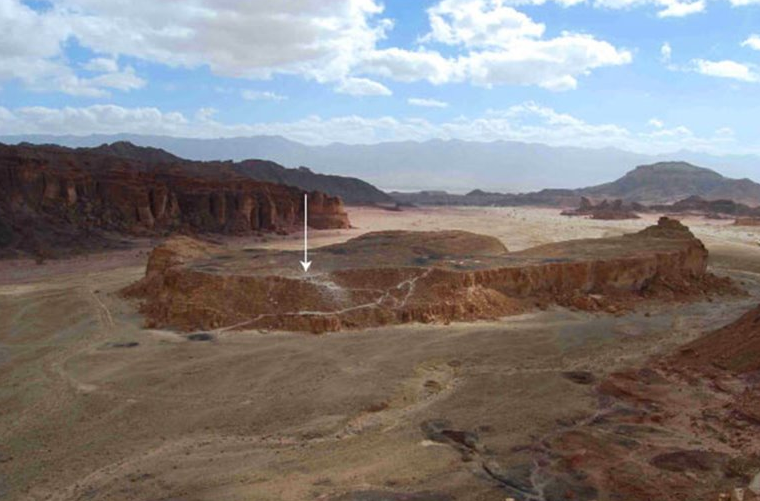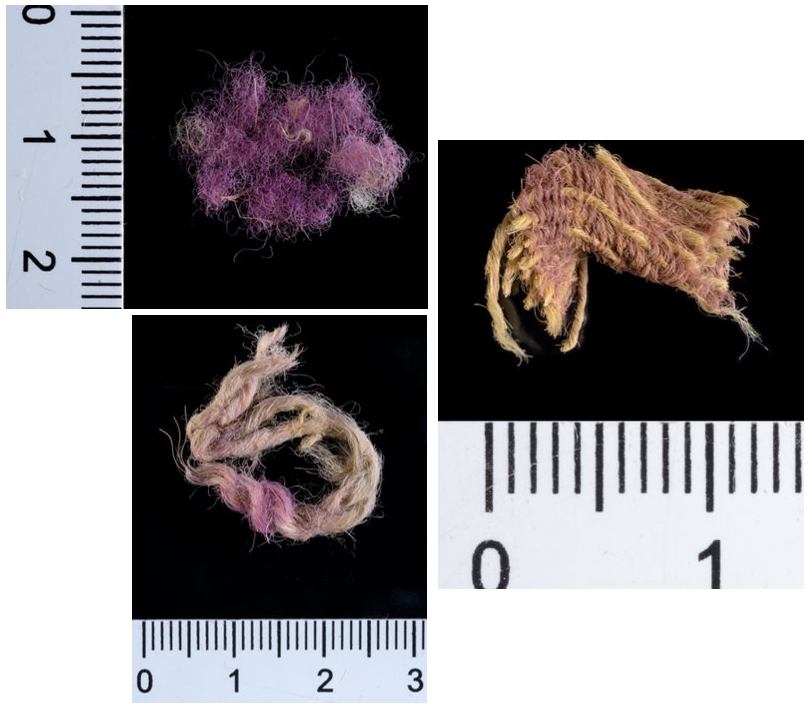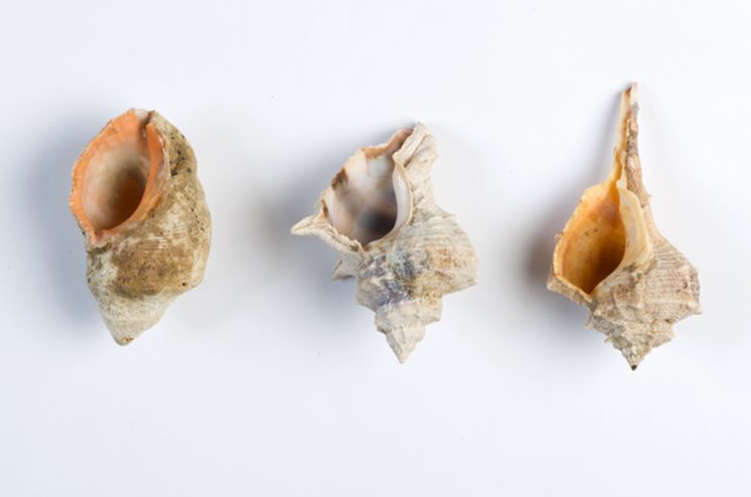Introduction
In January 2021, the Central Timna Valley (CTV) Project published in the online journal PLOS ONE the results of their excavations in the Timna Valley of southern Israel where they have been uncovering an ancient copper mining and smelting operation. This particular article focused on three specific items found in the excavation. Their report offered to the world – because this respected peer-reviewed research journal is available online to everyone – a special look into the world of the ancient Near East and the Bible.
Timna Copper Purple
Three dyed textile fragments were excavated at a site named “Slave’s Hill” by archaeologists in the 1930s within the Timna copper mining and smelting production district – once the territory of the ancient kingdom of Edom. In a shallow depression just above bedrock within a mixed locus of reddish sediments and crushed sandstone, wool yarn and fibers dyed with a purplish hue were found. The locus was tightly dated to the late 11th–early 10th centuries BC by both pottery and short-lived radiometric dating. This was the period of Kings David and Solomon.
Finding purple-dyed textiles from the biblical world is an amazing discovery. In fact, any find of 2,000+ year old textiles is rare – yet over 100 textile fragments have been found in the arid region of Timna. But, considered to be the stuff of royalty – because of the costly purple-dyeing process – such material found at a place called “Slaves Hill” would not be anticipated. The site, known to archaeologists today as “Site 34”, was so named by excavators in the 1930s because its isolated location suggested to them it would be the best place to keep control of the slaves who did the backbreaking daily work of the mines and smelting furnaces.

But CTV’s excavation on Site 34 demonstrated it to be an important smelting site and the folks working there were living large! Beyond the expensive threads, excavation also revealed animal bones representing better cuts of meat. These people ate well, including fish which likely came across the desert from the Mediterranean. This was not the diet of slaves but of highly regarded craftsmen with special skill sets and knowledge. So, what was once considered guarded slave quarters was actually a walled Iron Age industrial site with a chambered gatehouse – all presumably to protect sophisticated technology and technicians along with the valuable copper ingots they were creating.
While the CTV Project at Timna is under the direction of Prof. Erez Ben-Yosef of Tel Aviv University, the research on the textiles was carried out by Dr. Naama Sukenik, curator of organic finds for the Israel Antiquities Authority (these two also being primary authors of the PLOS ONE article) with additional analytics from Prof. Zohar Amar of Bar Ilan University. The other colored textiles found at Timna were all dyed with various plant-based dyes, all readily accessible and with a simpler dyeing process. Although found in 2013, it took several years to finalize their conclusions.
Sea Purple
The biggest question on everyone’s mind was whether these fragments were, in fact, colored by sea purple dye. There were a few different plant or animal dyes used in antiquity (often mixed with additives, mordants or other dyes) which gave a purplish hue. The most well-known were the scale insect kermes (Kermes ilicis) and the root of the madder plant (Rubia tinctorum). But the most expensive – thus famous and important – of the ancient purple dyes was sea purple, also called royal purple, true purple or Tyrian purple.

By the time the Timna chemical analyses were completed, researchers announced they had the first positively identified ancient sea purple-dyed cloth from the southern Levant. It comes from a context one thousand years before the sea purple dyeing industry became a significant topic of Roman philosophers, geographers, and historians.

Left: Flemish painter Peter Paul Reubens’s 1636 oil painting Hercules’ Dog Discovers Purple Dye. Considered a sketch painting, today it resides at the Musee Bonnat in Bayonne, France. Unfortunately, the shell looks more like a nautilus than murex. Note the city and harbor in the background – presumably representing Phoenician Tyre (modern Lebanon).
Credit: Ophelia2
Right: Tyrian coin (200 AD) possibly depicting the legend of sea purple and Hercules’ dog, who came away with a purple mouth. While much too large, this shell does look like murex H. trunculus.
Credit: Ptil Tekhelet
There are textual references for purple dye in Akkadian tablets from Nuzi dated to 1425 BC as well as 14th century BC references on tablets from Ugarit and Hatti. But, outside the Bible, the most references to ancient purple come from the Roman period – the greatest amount of text coming from first century AD Roman philosopher and naturalist Pliny the Elder. His Natural History, one of the largest single works from the Roman Empire to survive, purports to cover the entire field of ancient knowledge, based on the best authorities available to him. In Book IX of Natural History (“creatures of the seas, rivers and ponds”), he used six chapters (60-65) to discuss at length the special sea purple dye and the processes needed to take it from Mediterranean murex snails to the dyed garments.
In contrast to the numerous textual references to purple textiles and the dyeing industry, archaeological evidence of the same is still extremely limited. Among the Mediterranean’s earliest-known sea purple dye installations is the Cretan port city of Kommos, probably the harbor for the Minoan palace of Phaistos, three miles (six km) to the north. Within Kommos – in the central courtyard of palatial Building T – was found a stone-slab pavement with drainage channels. The area around this floor and channels was covered with crushed murex shells having small human-made holes in the body whorls (suggesting removal of the dye gland) and crushed shell fragments. Dated by associated pottery, the installation was in use as early as 1900 BC.
Additional direct evidence of the sea purple dye industry comes from sea purple stains on sherds – especially near the rims of ceramic basins. This would have been where the reduced dye-solution was exposed to air, and underwent oxidation turning the solution purple. Such have been found along southern Levantine coastal sites like Sarepta (Lebanon; 14th–13th centuries BC), Ugarit (15th–13th centuries BC), Tel Keisan (11th century BC), Tel Shikmona (10th–9th centuries BC), and Tel Kabri (7th century BC). Further direct evidence of sea purple dye came from the islands of Santorini and Rhodes, where purple pigments from murex snails were found in wall paintings dated to the 17th century BC.
Purple Cloth
Only a small number of sea purple-dyed textiles have been found in excavations. In Israel (until Timna) they all dated to the Roman period: two from Masada and three from a Judean desert cave in Wadi Murabba‘at. A similar picture also emerges from other regions of the ancient Near East, with only scant remains of pre-Roman cloth dyed with sea purple. The earliest of these sea purple textiles were found in Syria and are dated to the early second millennium BC, including from a burial at Chagar Bazar (18th–16th centuries BC) and cloth preserved in gypsum within Qatna’s palace along with other luxury items including gold, beads and jewelry. Early evidence of sea purple cloth was also found in burials in Stamna (Aetolia, Western Greece) dated to the 12th–11th centuries BC.
So, the sea purple-dyed textiles at Timna are rare – especially being found some distance from the Mediterranean. It is the earliest in the southern Levant and, by 1,000 years, the earliest in Israel – and dating to the time of David and Solomon!

Left to right: S. haemastoma, H. trunculus and B. brandaris
Credit:Shahar Cohen
The Timna analyses demonstrated that sea purple was produced from three species of murex indigenous to the Mediterranean Sea: The Banded Dye-Murex (Hexaplex trunculus), the Spiny Dye-Murex (Bolinus brandaris) and the Red-Mouthed Rock-Shell (Stramonita haemastoma). The dye was produced from a gland from multiple murex snails, which was removed, mixed together with sea water and heated. Over several days, the resulting chemical processes produces the dye.
It is now generally accepted that the two most precious ancient dyes, purple and blue (a light blue/azure), were both produced from these same murex – by exposing the solution to greater sunlight for longer periods. Greater light exposure produces azure/blue, without light exposure, the purple hue is produced. These two colors are often mentioned together in ancient sources (including the Bible), having symbolic and religious significance.

Credit: Shahar Cohen
Further analytical tests were conducted on the same three species of Mediterranean murex identified as the source of Timna’s three purple wool fragments. Prof. Amar and Dr. Sukenik attempted to recreate the same dyes and determine which species created what hues. To reconstruct the murex dyeing process, Prof. Amar traveled to Italy where he cracked thousands of murex (which the Italians eat) and produced raw material from their dye glands which was then used during hundreds of attempts to reconstruct ancient dyeing. Such an experiment allowed him to actually replicate the process and the resultant ancient sea purple (and blue).
Biblical Purple and Blue, too
There are standard biblical terms for purple. In the Hebrew OT, purple (‘argaman) is mentioned 42 times (including its Aramaic cognate ‘argwan in Daniel 5:7, 16, 29). In the Greek NT, purple (porphyra) is mentioned nine times. Based on our present knowledge, the ancient ‘purple’ of the Bible is to be understood as the sea purple, true purple or the famous Tyrian purple with shades likely ranging from purplish-red to violet-blue – and likely a little different hue with each new dye batch.
Finally, the other important biblical color in our study - blue (Hebrew tekelet) – is often mentioned outside the Bible as biblical or royal blue. Presumably, it represents something near the primary blue color. Blue (tekelet) is mentioned 26 times in Exodus with purple (‘argaman) and scarlet (tola’at shani) in reference to the Tabernacle and high priest’s vestments – with blue always first. An additional six independent references in Numbers, also related to the Tabernacle, suggests blue as the priority color of Israelite religious paraphernalia – and a spiritual focus of great Jewish interest today (see https://www.tekhelet.com). Thus, while purple was the special color of the rest of the ANE, blue was the most important color in ancient Israel.
Purple and Blue Biblical Insights
Exodus 25:4 blue, purple and scarlet and fine linen; goat hair…
Beginning here, ‘blue’, ‘purple’ and ‘scarlet’ are mentioned together in this order 26 times in Exodus, with the idea of each color being a different colored yarn or cloth. Blue was the priority color for Israelite religious paraphernalia. Also beginning here, ‘purple’ and ‘linen’ are mentioned together 31 times in the OT (3 in the NT) and it does not appear that the linen is dyed purple, but represents different material. Ancient textiles and modern experimentation suggest purple was almost always dyed on wool.
The two OT Hebrew terms, tola’at and shani, whether mentioned individually or together (43 times total), are understood to likely be referencing a single color alternately translated into English as crimson or scarlet. While other plant and animal-based dyes have been proposed for this color it is also possible that this color, too, came from the murex snails.
NT purple (Greek porphyra) was mentioned 9 times. While standardly the Greek NT term for purple, some translations call it “scarlet”.
Mark 15:17; John 19:2, 5 reference the purple robe put on Jesus at His trial.
Luke 16:19 speaks of Lazarus and the rich man who was clothed in purple and fine linen, representing two different articles of clothing – purple wool and fine white linen.
Acts 16:14 Lydia the seller of purple (Greek porphuropolis; “purple-seller”) from Thyatira but living in Philippi. Lydia had her own home with servants in Philippi and appears to be a wealthy woman. I suggest her involvement may have been with the purple dye industry back home in the important sea purple dyeing city of Thyatira – likely a family business. It is reasonable that the same family/business that collected the snails, created the dye, did the dyeing and likely did the sales, as well. As a wealthy Roman citizen, Lydia’s support for Paul and his team might indicate she is offering Roman world “patronage” to them for their provision and protection.
Revelation 17:4; 18:12, 16 referencing the purple garment of the Great Prostitute/Babylon in Revelation suggesting her wealth, power and influence.
Revelation 9:17 is the only mention of the color blue (huakinthinos) in the NT. It is referencing 2,000,000 mounted soldiers appearing after the sixth trumpet. They are all said to be wearing breastplates that were “fiery red, dark blue, and sulfurous yellow in color.” The term “blue” (huakinthinos; “dark blue” NIV, NET; but “jacinth” KJV [an orange-red stone]; “dark red” ESV) has been suggested as the basis of our English hyacinth and the color dark blue. If correct, the colors of 9:16 (fiery red, dark blue and sulfur yellow) could relate to the three plagues of 9:18 (fire, smoke and sulfur).
This article is based on the research of the Central Timna Valley Project report:
Sukenik N, Iluz D, Amar Z, Varvak A, Shamir O, Ben-Yosef E (2021) Early evidence of royal purple dyed textile from Timna Valley (Israel). PLOS ONE 16(1) https://doi.org/10.1371/journal.pone.0245897











